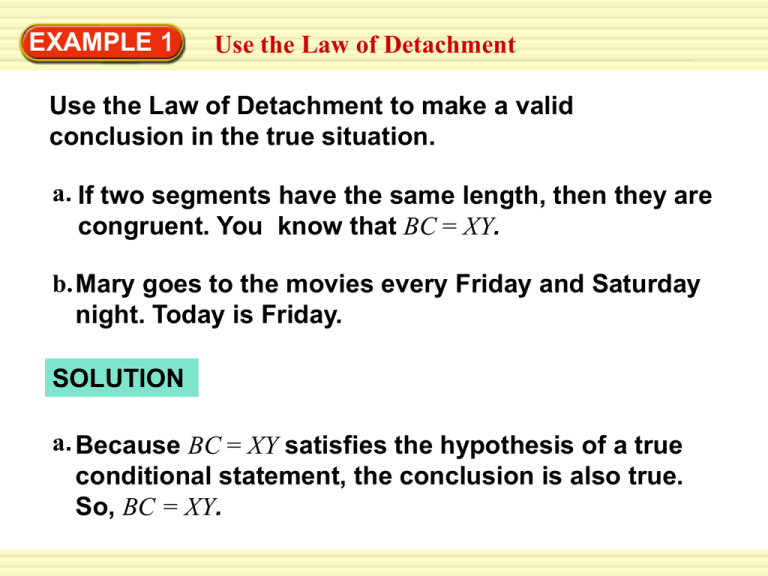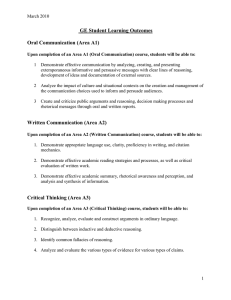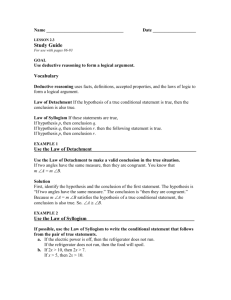EXAMPLE 1 Use the Law of Detachment
advertisement

EXAMPLE 1 Use the Law of Detachment Use the Law of Detachment to make a valid conclusion in the true situation. a. If two segments have the same length, then they are congruent. You know that BC = XY. b. Mary goes to the movies every Friday and Saturday night. Today is Friday. SOLUTION a. Because BC = XY satisfies the hypothesis of a true conditional statement, the conclusion is also true. So, BC = XY. EXAMPLE 1 Use the Law of Detachment b. First, identify the hypothesis and the conclusion of the first statement.The hypothesis is “If it is Friday or Saturday night,” and the conclusion is “then Mary goes to the movies.” “Today is Friday” satisfies the hypothesis of the conditional statement, so you can conclude that Mary will go to the movies tonight. EXAMPLE 2 Use the Law of Syllogism If possible, use the Law of Syllogism to write a new conditional statement that follows from the pair of true statements. a. If Rick takes chemistry this year, then Jesse will be Rick’s lab partner.If Jesse is Rick’s lab partner, then Rick will get an A in chemistry. b. If x2 > 25, then x2 > 20. If x > 5, then x2 > 25. c. If a polygon is regular, then all angles in the interior of the polygon are congruent. If a polygon is regular, then all of its sides are congruent. EXAMPLE 2 Use the Law of Syllogism SOLUTION a. The conclusion of the first statement is the hypothesis of the second statement, so you can write the following new statement. If Rick takes chemistry this year, then Rick will get an A in chemistry. b. Notice that the conclusion of the second statement is the hypothesis of the first statement, so you can write the following new statement. If x > 5, then x2 > 20. EXAMPLE 2 Use the Law of Syllogism c. Neither statement’s conclusion is the same as the other statement’s hypothesis. You cannot use the Law of Syllogism to write a new conditional statement. GUIDED PRACTICE for Examples 1 and 2 1. If 90° < m R < 180°, then R is obtuse. The measure of R is 155°. Using the Law of Detachment, what statement can you make? ANSWER R is obtuse GUIDED PRACTICE for Examples 1 and 2 2. If Jenelle gets a job, then she can afford a car. If Jenelle can afford a car, then she will drive to school. Using the Law of Syllogism, what statement can you make ? ANSWER Notice that the conclusion of the first statement is the hypothesis of the second statement, So you can write the following statement. If Jenelle gets a job, then she will drive to school. GUIDED PRACTICE for Examples 1 and 2 State the law of logic that is illustrated. 3. If you get an A or better on your math test, then you can go to the movies. If you go to the movies, then you can watch your favorite actor. If you get an A or better on your math test, then you can watch your favorite actor. ANSWER Law of Syllogism. GUIDED PRACTICE for Examples 1 and 2 4. If x > 12, then x + 9 > 20. The value of x is 14 Therefore, x + 9 > 20 ANSWER Law of Detachment EXAMPLE 3 Use inductive and deductive reasoning ALGEBRA What conclusion can you make about the product of an even integer and any other integer? SOLUTION STEP 1 Look: for a pattern in several examples. Use inductive reasoning to make a conjecture. (–2) (2) = –4, (–1) (2)= –2, 2 (2)= 4, 3 (2)= 6, (–2) (–4) = 8, (–1) (–4) = 4, 2 (–4)= –8, 3 (–4) = –12 Conjecture: Even integer Any integer = Even integer EXAMPLE 3 Use inductive and deductive reasoning STEP 2 Let: n and m each be any integer. Use deductive reasoning to show the conjecture is true. 2n is an even integer because any integer multiplied by 2 is even. 2nm represents the product of an even integer and any integer m. 2nm is the product of 2 and an integer nm. So, 2nm is an even integer. ANSWER The product of an even integer and any integer is an even integer. EXAMPLE 4 Reasoning from a graph Tell whether the statement is the result of inductive reasoning or deductive reasoning. Explain your choice. a. The northern elephant seal requires more strokes to surface the deeper it dives. b. The northern elephant seal uses more strokes to surface from 250 meters than from 60 meters. EXAMPLE 4 Reasoning from a graph SOLUTION a. Inductive reasoning, because it is based on a pattern in the data b. Deductive reasoning, because you are comparing values that are given on the graph GUIDED PRACTICE for Examples 3 and 4 5. Use inductive reasoning to make a conjecture about the sum of a number and itself. Then use deductive reasoning to show the conjecture is true. SOLUTION Conjecture: The sum of a number and itself is twice the number. Deductive reasoning: Let n be any integer. Use deductive reasoning to show the conjecture is true n + n = 2n GUIDED PRACTICE for Examples 3 and 4 6. Use inductive reasoning to write another statement about the graph in Example 4. Then use deductive reasoning to write another statement. SOLUTION Using inductive reasoning: The more strokes it takes for the northern elephant to surface, the deeper it dove. Using deductive reasoning: The northern elephant seal uses fewer strokes to surface from 190 meters then from 410 meters.



